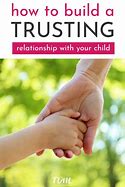Top Communication Strategies For Building Trust Between Parents & Kids
Trust is the cornerstone of any healthy relationship, and the bond between parents and their children is no exception. When trust is present, communication flows freely, and both parties feel safe and supported. However, building and maintaining trust in a parent-child relationship can sometimes feel like an uphill battle. That’s why we’ve put together these effective communication strategies to help you navigate this journey.
Creating Space for Meaningful Connections: Quality Time
In today’s fast-paced world, it’s more crucial than ever for parents to make quality time a priority. This doesn’t have to be elaborate, just consistent and dedicated time spent together without distractions. Whether it’s having dinner together as a family, going for a walk, or simply sitting down to chat, this dedicated time shows your child that you value their presence and want to connect with them.
Here are some tips for making the most of quality time:
- Schedule it in: Just like you’d schedule appointments, schedule regular time for family bonding. This can help ensure it doesn’t get pushed aside by other commitments.
- Be present: When you’re spending time with your child, put away your phone and other distractions, and focus on being fully engaged. Active listening shows that you’re genuinely interested in what they have to say.
- Create shared experiences: Engaging in activities together, whether it’s playing games, reading books, or going on adventures, helps create lasting memories and strengthens your connection.
Listening with Empathy: Understanding Your Child's Perspective
True communication involves more than just talking; it requires listening. And when we’re listening to our kids, it’s important to go beyond simply hearing their words. We need to listen with empathy, trying to understand their perspective and feelings.
Here’s how to practice active listening:
- Make eye contact and nod your head: This demonstrates that you’re paying attention and engaged in the conversation.
- Reflect back what you hear: Paraphrase what your child has said to ensure you understand their point of view.
- Avoid interrupting: Let your child finish their thoughts without jumping in with your own opinions or solutions.
- Validate their feelings: Even if you don’t agree with what your child is saying, acknowledge their feelings and let them know that you understand.
Open and Honest Communication: Building Trust with Transparency
Trust is built on a foundation of openness and honesty. When you communicate openly with your child, you show them that you’re trustworthy and that they can confide in you.
Here are some tips for fostering open communication:
- Be upfront and honest: Even when discussing sensitive topics, be truthful with your child. They’ll appreciate your honesty in the long run.
- Avoid secrets: Keep your communication transparent, and avoid keeping secrets from your child. This can make them feel like they can’t trust you.
- Be willing to share your own experiences: Sharing your own struggles and triumphs can help your child feel less alone and more connected to you.
- Create a safe space for communication: Let your child know that they can come to you with anything, and that you won’t judge them.
Respecting Boundaries: Giving Your Child Space and Autonomy
As children grow older, they naturally crave more autonomy and independence. Respecting their boundaries is crucial to building trust and fostering a healthy relationship.
Here’s how to respect your child’s boundaries:
- Give them space when they need it: Don’t force your child to engage with you when they’re clearly needing time alone.
- Respect their privacy: Avoid invading their personal space, like their bedroom or belongings, without their permission.
- Allow them to make their own decisions: Give your child age-appropriate opportunities to make choices and take responsibility for their actions.
- Listen to their concerns: Take their feelings seriously and don’t dismiss their opinions or concerns.
Positive Language: Focusing on Solutions and Reinforcement
The way we speak to our children significantly impacts their self-esteem and our relationship with them. Using positive language is crucial for creating a supportive and trusting environment.
Here’s how to use positive language:
- Focus on solutions, not problems: Instead of focusing on what your child did wrong, talk about how they can fix the situation.
- Offer encouragement and praise: Recognize your child’s efforts, no matter how small, and offer genuine praise for their accomplishments.
- Avoid criticism and negativity: Using harsh words or putting your child down can damage their confidence and hinder communication.
- Use “I” statements: Instead of accusing your child, use “I” statements to express your feelings and needs.
Managing Conflicts Calmly: Teaching Healthy Dispute Resolution
Conflicts are inevitable in any relationship, and learning to navigate them constructively is essential. When disagreements arise, approach them with a calm demeanor and teach your child healthy conflict resolution skills.
Here are some tips for managing conflict calmly:
- Stay calm and respectful: Avoid yelling or getting angry.
- Listen to each other’s perspectives: Encourage both parties to express their views without interruption.
- Find common ground: Focus on finding solutions that work for both parties.
- Compromise: Be willing to make concessions and find a middle ground.
Avoiding Physical and Emotional Punishment: Building Discipline with Respect and Love
Physical or emotional punishment is never an effective or appropriate way to discipline a child. These methods can damage trust, create fear, and lead to long-term emotional damage.
Here are some alternatives to physical and emotional punishment:
- Set clear expectations and boundaries: Clearly communicate your rules and consequences for breaking them.
- Use natural consequences: Allow your child to experience the natural consequences of their actions, such as missing out on an activity because they didn’t complete their chores.
- Focus on positive reinforcement: Reward your child for good behavior and effort.
- Use time-outs: If your child is out of control, give them a quiet time-out to calm down.
- Communicate your expectations clearly: Talk to your child about what you expect from them and explain the reasons behind your rules.
Apologizing and Making Amends: Showing Humility and Acknowledging Mistakes
Everyone makes mistakes, even parents. Apologizing to your child when you’ve made a mistake shows them that you’re humble and that you value your relationship with them.
Here’s how to apologize effectively:
- Acknowledge your mistake: Take responsibility for your actions and don’t try to blame someone else.
- Express regret and sincerity: Let your child know that you’re sorry and that you care about their feelings.
- Make amends: If possible, try to fix the situation or make up for your mistake.
Building Confidence: Providing Support and Believing in Their Abilities
Children thrive on encouragement and belief in their abilities. When parents express confidence in their children, they help them develop self-esteem and a sense of competence.
Here’s how to build your child’s confidence:
- Praise their efforts: Focus on their hard work, determination, and progress, not just on their outcomes.
- Encourage their interests: Support their passions and hobbies, even if they’re not traditional.
- Set realistic expectations: Don’t push your child beyond their capabilities, but gently challenge them to stretch their limits.
- Be patient and supportive: Encourage them to try new things and don’t be afraid of failure.
Leading by Example: Building Trust through Actions and Attitudes
Children learn by observing, and they’re constantly watching their parents’ actions. Being a role model for the kind of communication and behavior you want to see in your child is crucial for building trust.
Here’s how to be a good role model:
- Practice what you preach: If you want your child to be honest, be honest yourself.
- Show respect for others: Treat your child with respect and show respect for others.
- Be a good listener: Show your child that you’re willing to listen to their perspective.
- Be emotionally available: Let your child know that you’re there for them, both physically and emotionally.
Conclusion:
Building trust between parents and children is an ongoing process that requires effort and dedication. By implementing these effective communication strategies, parents can create a strong, respectful, and loving bond with their children. Open and honest communication will help children grow into confident and responsible individuals who feel secure in their relationships. Remember, fostering trust is a journey, not a destination. Embrace the challenges and celebrate the victories along the way.
FAQ
What if my child doesn’t want to talk to me?
It’s normal for children to have times when they’re less open to communicating. Don’t force them to talk if they’re not ready. Let them know that you’re there for them when they’re ready to open up.
What if I’m having trouble communicating with my teenager?
Teenagers are going through a lot of changes and may seem distant or uninterested in talking to their parents. Try to find common ground, listen to their concerns, and create opportunities for shared activities that can open up communication.
How can I build trust with my child after a major conflict?
Apologize sincerely, take responsibility for your actions, and work to repair the damage. It may take time for trust to be rebuilt, but patience and continued effort will show your child that you’re committed to rebuilding the relationship.
How can I address a situation where my child is lying to me?
When lying occurs, it’s important to address it in a calm and respectful manner. Focus on understanding the reasons behind the lie and work to establish a sense of trust again. Open communication, consistency, and empathy are key to addressing these challenging situations.

